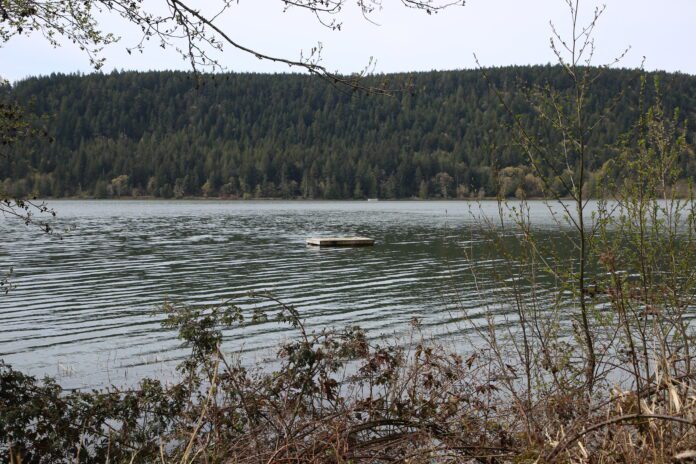In the wake of an unexpected $10 million funding windfall, Salt Spring’s largest water improvement district has begun a complex planning process, centred on how those dollars will be used — and discussions with the province have begun on how raising the weir level at St. Mary Lake can improve the island’s resiliency to a changing climate.
The funding appeared without advance notice in the B.C. government’s 2024/25 budget announcement in late February, allocating money to increase water storage capacity and better sustain the required environmental water flow through Duck Creek by “raising the dam height” at St. Mary Lake.
That wording seemed to cause some initial public confusion; the North Salt Spring Waterworks District (NSSWD) operates a weir at the lake, which — unlike a dam — is designed to allow water to flow over its top during periods of higher rainfall. Raising the weir’s level would not, according to staff, directly translate to raising the level of St. Mary Lake, but rather would increase effective capacity by allowing more flexibility in managing lake levels and flow into Duck Creek throughout the year.
NSSWD operations manager Ryan Moray explained at the current height of the weir — 40.7 metres above North American coastal mean sea level — water cascades over the top for much of the winter, especially during periods of high rainfall. Those rain events seem to be happening with increasing frequency, according to NSSWD data collected at St. Mary Lake, particularly in January and February — and, Moray added, if the weir was raised to a height of 41 metres as currently envisioned, water would still be pouring over during periods of heavy precipitation.
“You can see during prior years where we peaked, we were seeing lake levels as high as 41.20,” said Moray.
NSSWD’s examination of climate change data — part of its own recent storage investigations during an ongoing “moratorium roadmap” project — had already suggested a need to find water capacity management solutions due to changing rainfall patterns; the provincial funding is specifically categorized under B.C.’s response to climate emergencies. CAO Mark Boysen told trustees that district staff had already begun preliminary meetings with representatives from relevant provincial ministries.
“I’d say we’re at the very early stages,” said Boysen. “The ministries are talking to each other, and ee’ve had some very good initial conversations about eligibility for where the funding could go, what would be possible and potentially not possible.”
NSSWD board chair Brian Pyper emphasized the board’s hope that discussions for using that funding toward climate resilience goals would remain “as broad as we can,” possibly looking beyond the weir to other water storage and management projects the district had been considering.
“We know a lot could be under that [climate resiliency] umbrella,” said Pyper. “Not necessarily just the weir.”
Until the project goals crystallize, according to Boysen, the weir — and water flows into Duck Creek — remains the focus; interestingly, he said, there was still an active — if stalled — application to raise the weir from an effort nearly a decade ago.
“The province has pulled those documents out,” said Boysen, “from back in 2015 or 2016, and we’re going to see what has to be updated, and whether we’ll be able to continue with the active application or if we have to renew.”
The district will be developing a work plan with the province, Boysen said, that will move toward funding agreements and eventually designs and public engagement.
“Because it is a one-off funding program, not a grant, we’re not required to contribute matching funds or anything,” he said. “It’s kind of outside of a typical structure for their funding. But there’s a lot of information to go through.”
Staff confirmed any new weir construction would be designed to help limit lake elevation gains during heavy rains, possibly reducing the amount of time spent at higher levels — which may come as some relief to landowners around the lake.
“Thanks to the provincial funding, we have an opportunity to do it right, and have it last long into the future,” said Pyper. “Operating in a way that we design it.”

